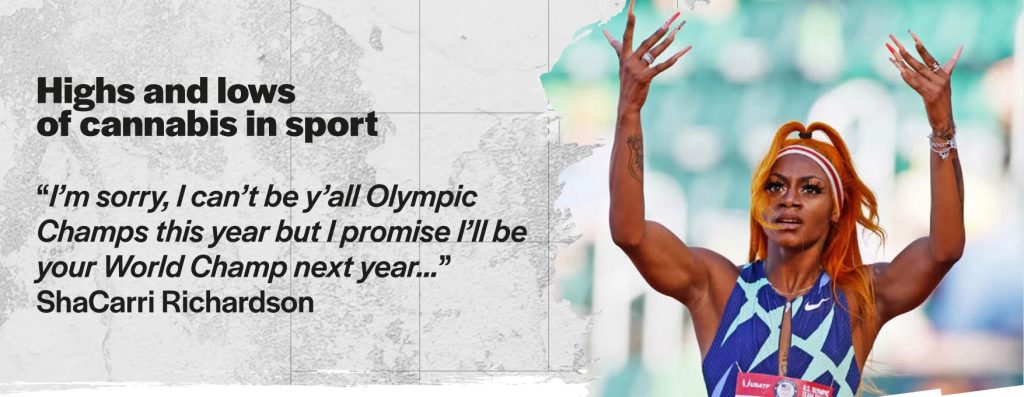If you imagine a drowsy and relaxed cannabis-smoker, then you’re probably not thinking of a pro athlete.
Your stereotype is partly true, but moderate dosage and willpower can overcome some side effects – especially for the personality type which becomes keen athletes.
This is how some turn cannabis into a sports advantage:
Muscle relaxation is amazing to avoid cramps in an endurance race.
Decreased anxiety, fear, depression and tension can lead to a more focused mind.
A “detached” attitude has led to more risk-taking behaviour, but without affecting tactics and decision making.*
Last but not least, research found that cannabis can improve oxygenation to the tissues – a big gain in almost all sports.
Clearly not something that you want your opponent to be on!
And what about your own performance – what would you jeopardise if you picked up a cannabis habit?
Addictive medication
Cannabis Sativa is known under so many names, it’s clearly a plant with a lot of fans!
The cultivation and use of cannabis is nothing new. Through the entire history of humanity, Cannabis Sativa leaves have been used to heal many minor diseases and to minimise pain***.
If you ever wondered how to spell cannabis in Sumerian or Akkadian, here is your answer:
It is particularly effective against chronic pain (weird concept for kids and teens, but wait until you get a little older…), not only masking pain, but reducing it permanently**.
Unlike tobacco, cannabis is known to help lung capacity. Yes, it is shockingly true: inhaling small amounts of it in a pure, organic form, cannabis helps your bronchi and blood vessels to absorb oxygen***.
In addition to that, recent research would indicate that some of the chemicals within this plant help control your weight and even diabetes! A cannabis compound seems to regulate hunger and insulin receptors in our brain***.
No wonder some businesses cultivate hemp, a cannabis derivative from which a very high quality protein powder can be extracted for industrial use and for supplements, with a stunning biological value of 87****!
Bear in mind though that cannabis is mostly illegal to possess despite the medical trials mentioned above. The top global health policy adviser – WHO – classifies it as hazardous. And WADA – the World Anti-Doping Agency – prohibits cannabis.
Why has it become so negatively associated with addiction and crime? Is this even relevant in sports?
Performance-enhancing weed?
Blacklists of performance enhancing drugs are there to ensure fair play.
Here are the WADA criteria for banning a drug*****:
- Potential to enhance or proof of enhancing sports performance;
- Evidence of a potential or actual health risk to the athlete;
- Its use violates the spirit of sport.
I’ve already listed why cannabis enhances performance. But WADA is also bearing in mind the risks which cannabis-takers run.
When smoked in larger amounts, cannabis leaves in the form of joints are toxic. Smoking joints decrease coordination, distorts spatial perception and alters your perception and awareness of the passage of time. Eventually, it permanently damages your brain with little or no hope of recovery. On a lesser scale than alcohol or opioids, it creates addiction. Everything addictive leads to dysfunctional behaviours, loss of interest in social activities and detachment from loved ones.******
If you neglect the above you run the risk of a proper psychotic syndrome. At that point, reality slips through your fingers. Hallucinations, delusions, seizures are just some examples of this irreversible state. No wonder WADA is concerned about cannabis!*******
In the countries where cannabis is a regulated drug, moderation is key. Like any other drug, it has the potential to help in the right context, and to harm when we lose track of common sense.
References
*Kennedy M. C. (2017) ‘Cannabis: exercise performance and sport. A systematic review’, Journal of science and medicine in sport, 20, 825-829.
**Russo E. B. (2007) ‘History of cannabis and its preparations in saga, science, and sobriquet.’ Chemistry and biodiversity, 4, 1614-1648.
***Pisanti S., Malfitano A. M., Ciaglia E., Lamberti A., Ranieri R., Cuomo G., Abate M., Faggiana G., Proto M. C., Fiore D., Laezza C., Bifulco M. (2017) ‘Cannabidiol: state of art and new challenges for therapeutic applications.’ Pharmacology and therapeutics, 1-19.
****Shen P., Gao Z., Fang B., Rao J., Chen B. (2021) ‘Ferreting out the secrets of industrial hemp protein as emerging functional food ingredients.’ Trends in food science and technology, 112, 1-15.
*****Mazzoni I., Barroso O., Rabin O.(2011) ‘The list of prohibited substances and methods in Sport: structure and review process by the World Anti-Doping Agency.’ Journal of analytical toxicology, 35, 608-612.
******Thayer R. E., York S., Hollis H. C., Sabbineni A., Ewing A. F., Bryan A. D. (2017) ‘Structural neuroimaging correlates of alcohol and cannabis use in adolescents and adults.’ Society for the study of addiction, 15.
*******Colizzi M., Murray R. (2018) ‘Cannabis and psychosis: what do we know and what should we do?’. British Journal of psychiatry, 212, 195-196.
Further reading
Huestis M. A., Mazzoni I., Rabin O. (2011) ‘Cannabis in sport: anti-doping perspective.’ Sports medicine, 41(11), 949-966.
WHO (2021) Psychoactive drugs – Cannabis. [Online] Available from:
SportingNews (2021) Sha ‘Carri Richardson disqualified from Olympics. [online] Available from: https://www.sportingnews.com/us/athletics/news/shacarri-richardson-olympics-runner-weed/12f4cgokp9faq1uqnbylnsl2to






